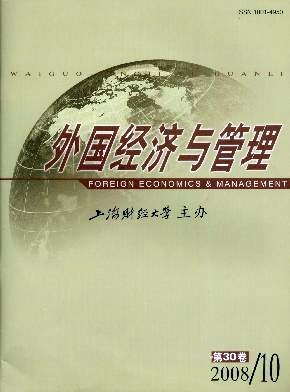最优组织复杂性理论探析
外国经济与管理 2008 年 第 30 卷第 10 期, 页码:59 - 65
摘要
参考文献
摘要
环境复杂多变,越来越多的企业开始陷入组织复杂性困境,而更多的研究者及实践者开始追求最优组织复杂性。本文在分析、整理相关文献后认为:在组织成长的每个阶段都存在一个最优组织复杂性状态;当组织处于这一状态时,其自身复杂性与环境复杂性相匹配;如果组织能通过自组织、自学习、非线性正负反馈等机制来调适自身的复杂性,并使之与环境复杂性相匹配,组织就能持续动态地接近最优组织复杂性状态;这时的组织具有最强的生命力和创造力。
[1]Tang,Z.Organizational complexity:Assumption,utility,and cost[D].Tudcaloosa,The University of Alabama,2006.
[2]Carroll,T,and Burton,R M.Organizations and complexity:Searching for the edge of chaos[J].Computational and Mathematical Or-ganization Theory,2000,6(4):319-337.
[3]Kauffman,S A.At homeinthe university:The searchfor laws of self-organization and complexity[M].New York:Oxford University Press,1995.
[4]Stacey,R D.Complexity and creativity in organizations[M].San Francisco:Berret Koehler Publishers,1996.
[5]Rybakov,L A.The philosophy of the structures of organizations:The evolutionary approach[M].Kiev:I AI,1997.
[6]Rybakov,L A.Environment and complexity of organizations[J].Emergence,2001,(4):83-94.
[7]White,MC,Marin,D B,Brazeal,D,Friedman,V,and William,H.The evolution of organizations:Suggestions fromcomplexity theoryabout the interplay between natural selection and adaptation[J].Human Relations,1997,50(11):1 383-1 401.
[8]Morel,B,and Ramanujam,R.Throughthelooking glass of complexity:The dynamics of organizations as adaptive and evolving systems[J].Organization Science,1999,10(3):278-293.
[9]Bollinger,J,Sprott,J C,and Mladenoff,DJ.Self-organization and complexityin historical landscape patterns[J].OIKOS,2003,100:541-553.
[10]Haddadj,S.Organization change and the complexity of succession[J].Journal of Organizational Change Management,2003,16(2):135-153.
[11]Grobman,G M.Complexity theory:Anew way tolook at organizational change[J].Public Administration Quarterly,2005,29(3/4):351-384.
[12]Peter Smith.Implications of complexity and chaos theories for organizations that learn[J].Learning Organization,2003,10(6):321-324.
[13]Frans,M,Eijnatten,V,and Putnik,G D.Chaos,complexity,learning,and the learning organization:Towards a chaordicenterprise[J].Learning Organization,2004,11(6):418-429.
[14]Damanpour,F.Organizational complexity and innovation:Developing and testing multiple contingency models[J].Management Sci-ence,1996,42(5):693-716.
[15]Moldoveanu,MC,and Bauer,R.Onthe relationship between organizational complexity and organizational structuration[J].Organiza-tion Science,2004,15:98-118.
[16]Siggelkow,N.Speed and search:Designing organizations for turbulence and complexity[J].Organization Science,2005,16(2):101-122.
[17]Boisot,M,and Child,J.Organizations as adaptive systems in complex environments:The case of China[J].Organization Science,1999,10(3):237-52.
[18]Heywood,S,Spungin,J,and Turnbull,D.Cracking the complexity code[J].McKinsey Quarterly,2007,2:84-95.
[19]Beinhocker,E D.Managingin a complex world[J].McKinsey Quarterly,2007,2:4-5.
[20]Saksena,S.Managing complexity:Howto capture latent value from products,customers,and operations[J].Business PerformanceManagement,2007,8:4-8.
[2]Carroll,T,and Burton,R M.Organizations and complexity:Searching for the edge of chaos[J].Computational and Mathematical Or-ganization Theory,2000,6(4):319-337.
[3]Kauffman,S A.At homeinthe university:The searchfor laws of self-organization and complexity[M].New York:Oxford University Press,1995.
[4]Stacey,R D.Complexity and creativity in organizations[M].San Francisco:Berret Koehler Publishers,1996.
[5]Rybakov,L A.The philosophy of the structures of organizations:The evolutionary approach[M].Kiev:I AI,1997.
[6]Rybakov,L A.Environment and complexity of organizations[J].Emergence,2001,(4):83-94.
[7]White,MC,Marin,D B,Brazeal,D,Friedman,V,and William,H.The evolution of organizations:Suggestions fromcomplexity theoryabout the interplay between natural selection and adaptation[J].Human Relations,1997,50(11):1 383-1 401.
[8]Morel,B,and Ramanujam,R.Throughthelooking glass of complexity:The dynamics of organizations as adaptive and evolving systems[J].Organization Science,1999,10(3):278-293.
[9]Bollinger,J,Sprott,J C,and Mladenoff,DJ.Self-organization and complexityin historical landscape patterns[J].OIKOS,2003,100:541-553.
[10]Haddadj,S.Organization change and the complexity of succession[J].Journal of Organizational Change Management,2003,16(2):135-153.
[11]Grobman,G M.Complexity theory:Anew way tolook at organizational change[J].Public Administration Quarterly,2005,29(3/4):351-384.
[12]Peter Smith.Implications of complexity and chaos theories for organizations that learn[J].Learning Organization,2003,10(6):321-324.
[13]Frans,M,Eijnatten,V,and Putnik,G D.Chaos,complexity,learning,and the learning organization:Towards a chaordicenterprise[J].Learning Organization,2004,11(6):418-429.
[14]Damanpour,F.Organizational complexity and innovation:Developing and testing multiple contingency models[J].Management Sci-ence,1996,42(5):693-716.
[15]Moldoveanu,MC,and Bauer,R.Onthe relationship between organizational complexity and organizational structuration[J].Organiza-tion Science,2004,15:98-118.
[16]Siggelkow,N.Speed and search:Designing organizations for turbulence and complexity[J].Organization Science,2005,16(2):101-122.
[17]Boisot,M,and Child,J.Organizations as adaptive systems in complex environments:The case of China[J].Organization Science,1999,10(3):237-52.
[18]Heywood,S,Spungin,J,and Turnbull,D.Cracking the complexity code[J].McKinsey Quarterly,2007,2:84-95.
[19]Beinhocker,E D.Managingin a complex world[J].McKinsey Quarterly,2007,2:4-5.
[20]Saksena,S.Managing complexity:Howto capture latent value from products,customers,and operations[J].Business PerformanceManagement,2007,8:4-8.
引用本文
吕鸿江, 刘洪, 程明. 最优组织复杂性理论探析[J]. 外国经济与管理, 2008, 30(10): 59–65.
导出参考文献,格式为:
上一篇:绿色广告研究述评





 7443
7443  664
664

